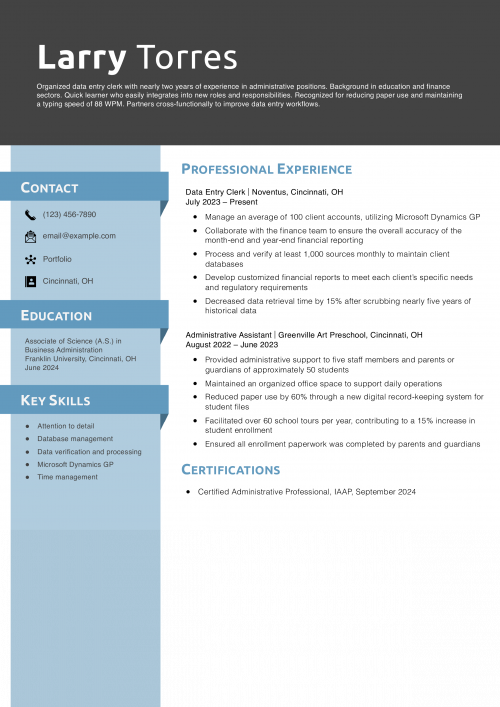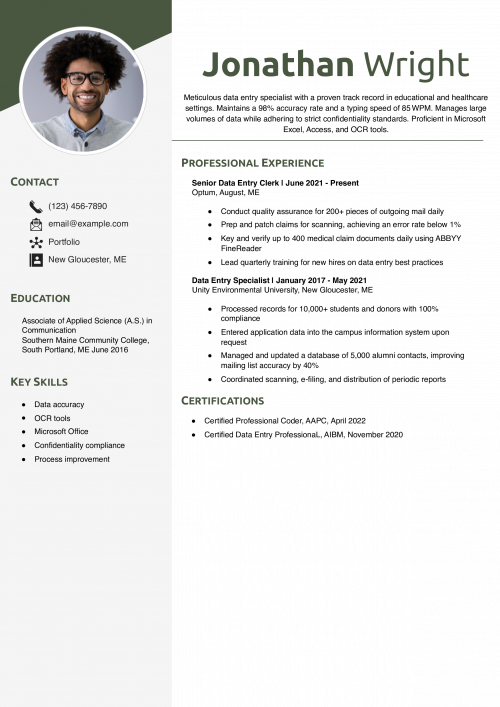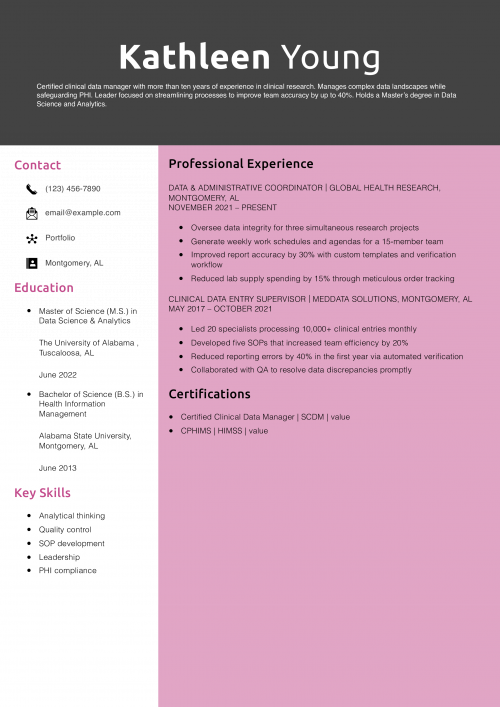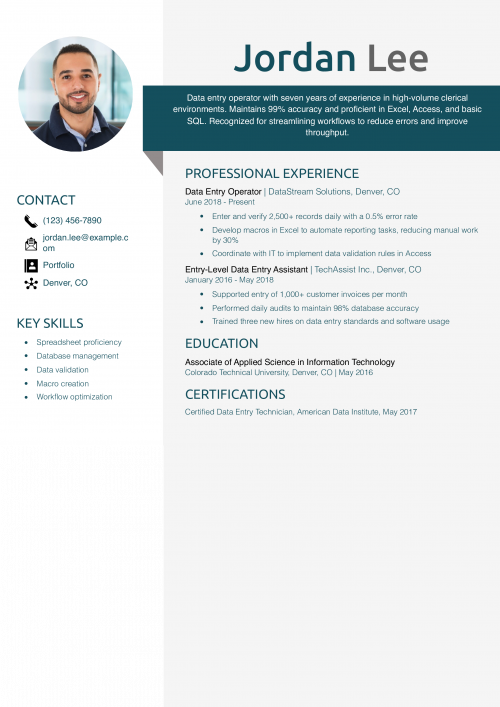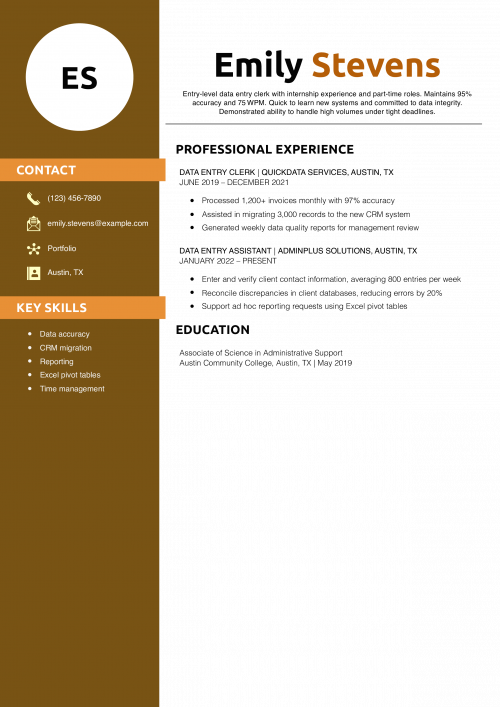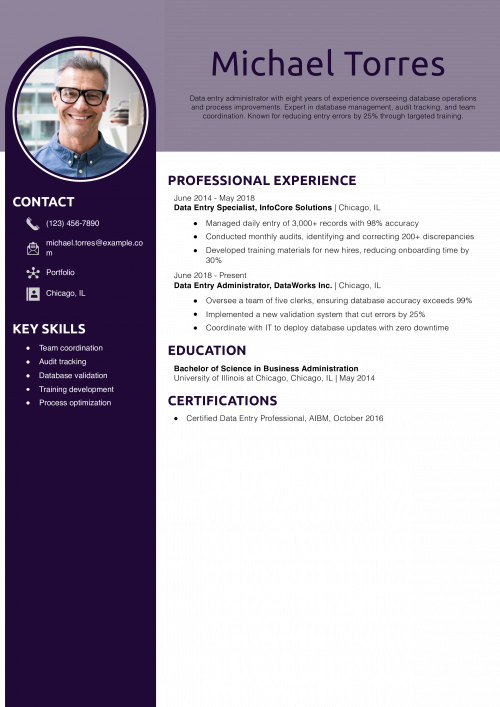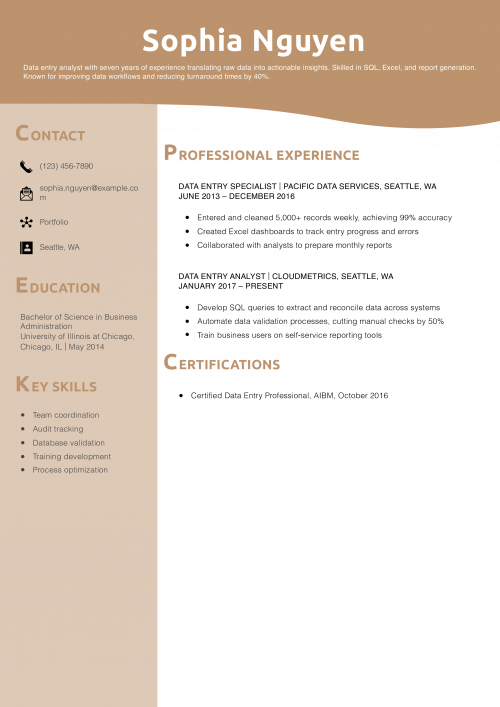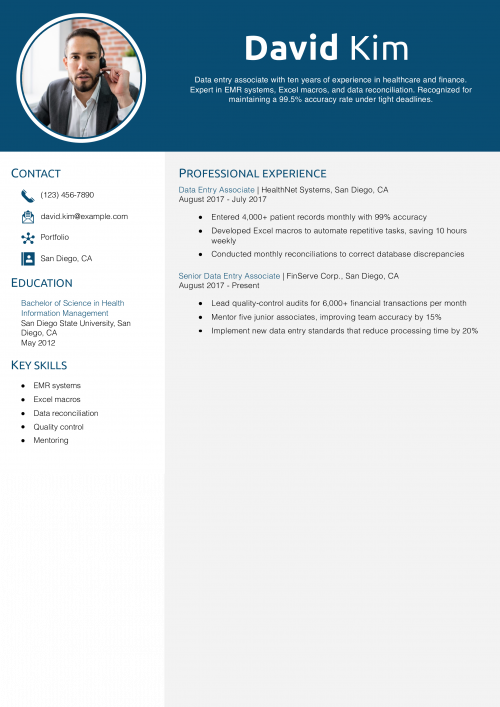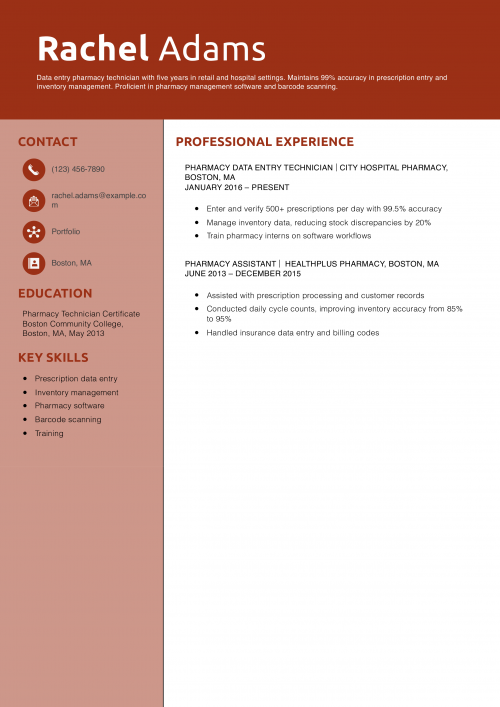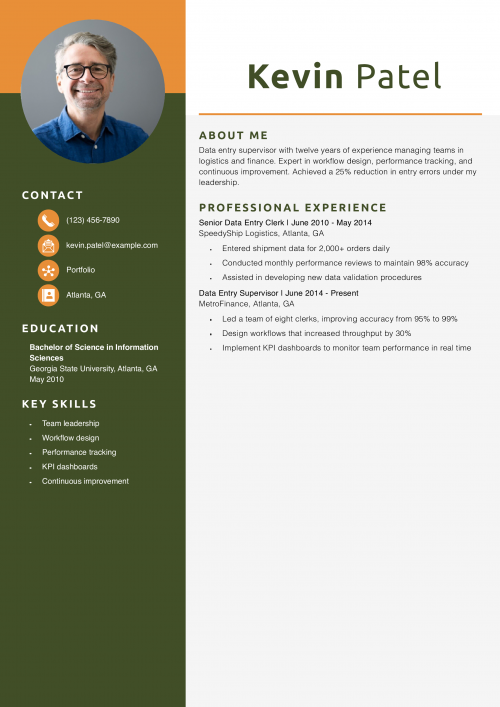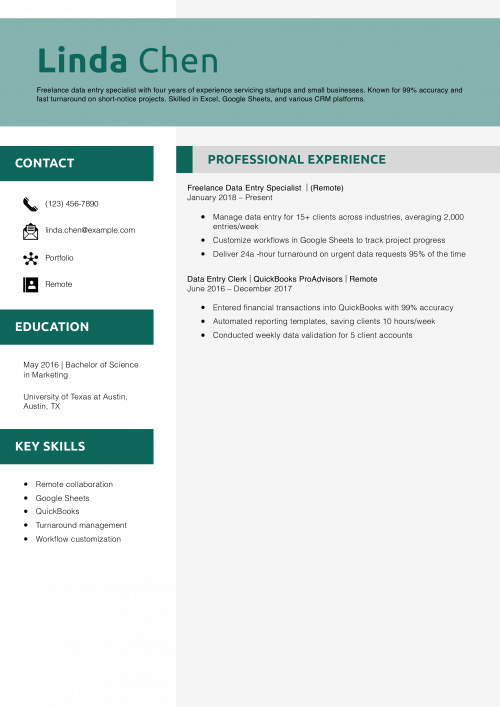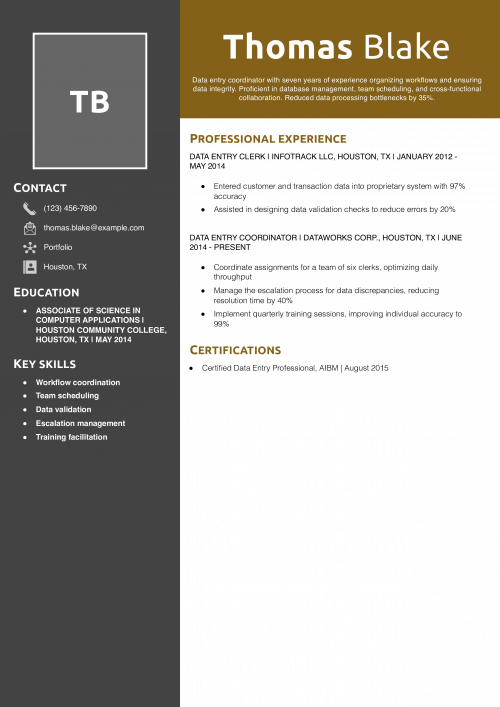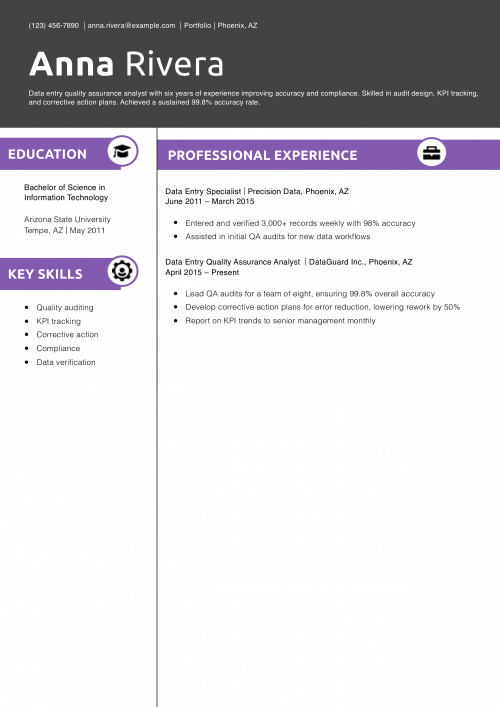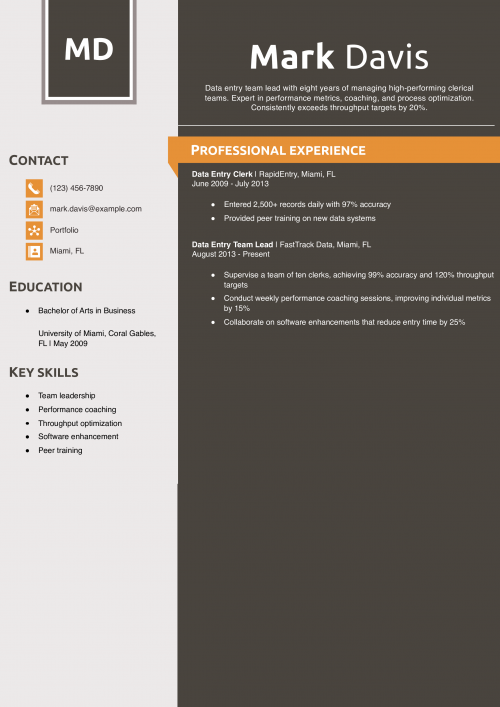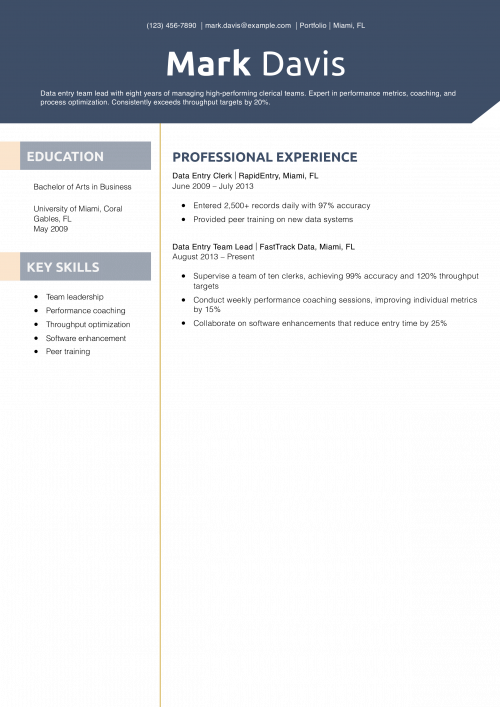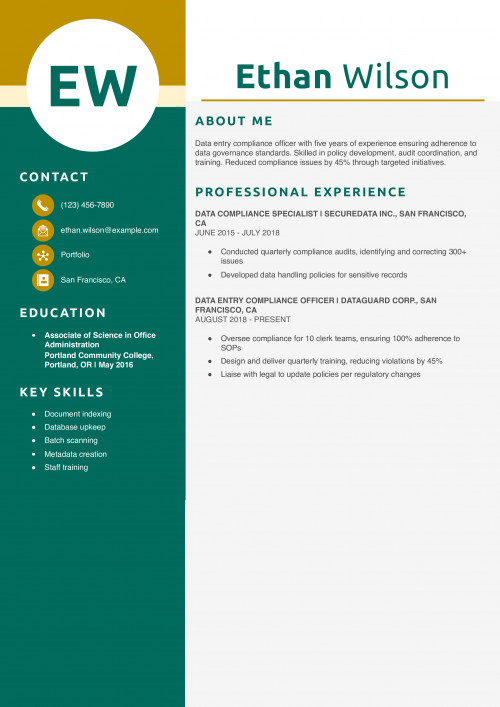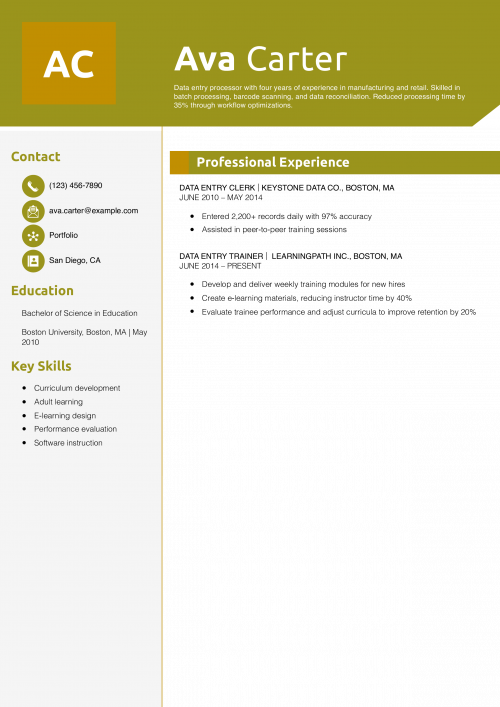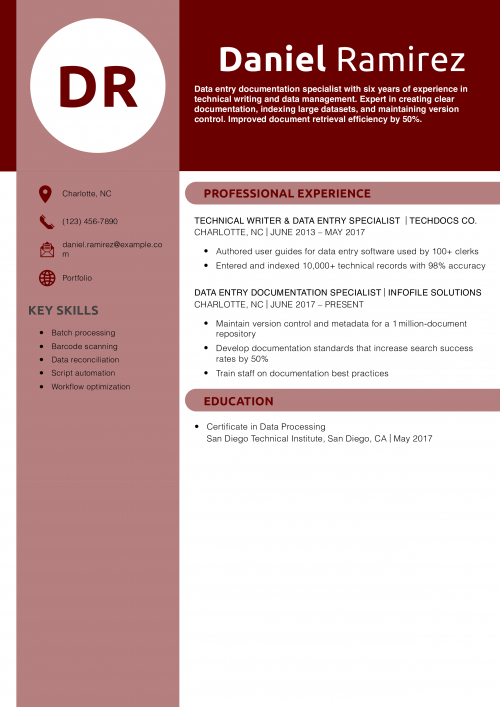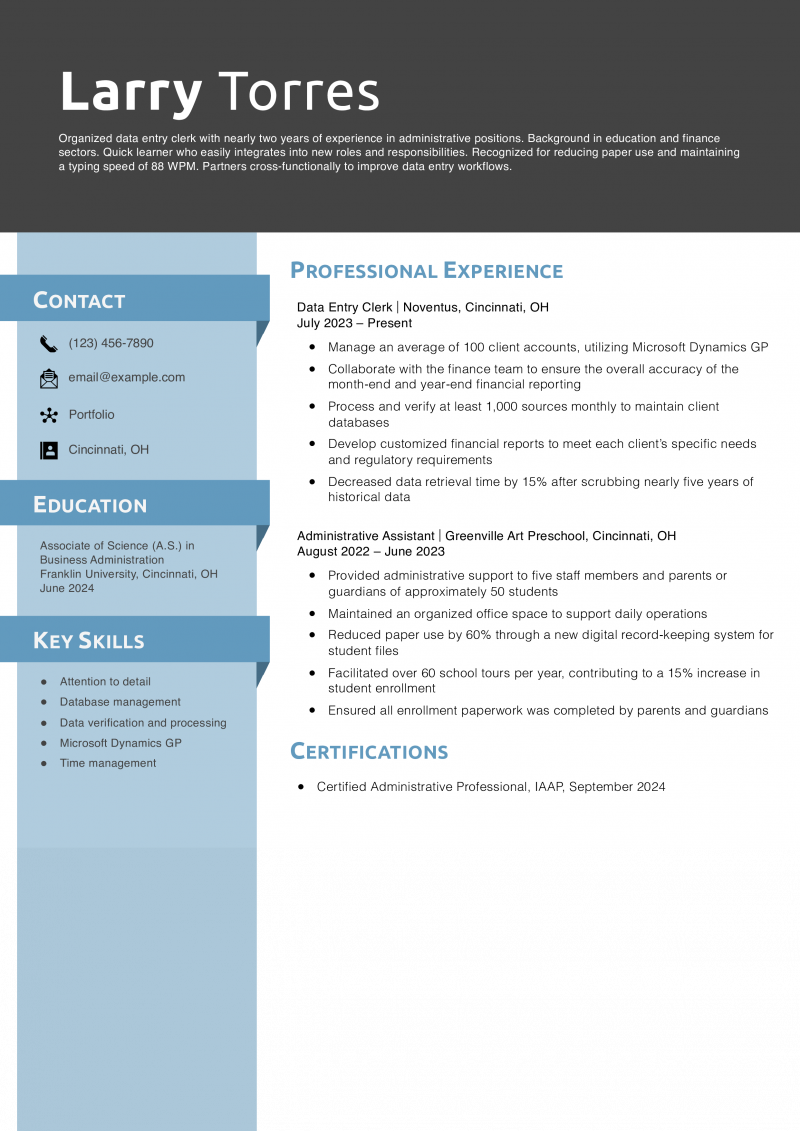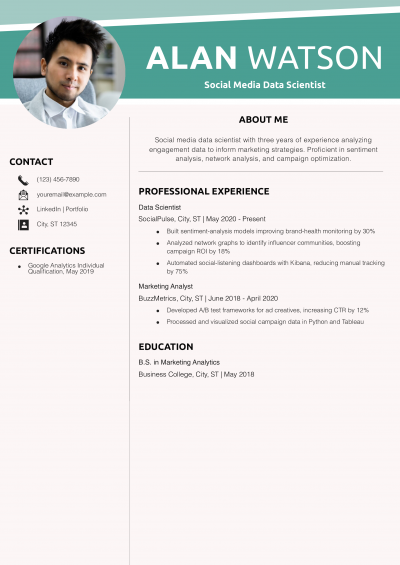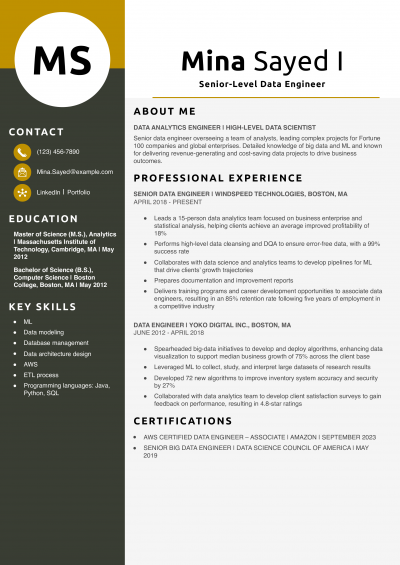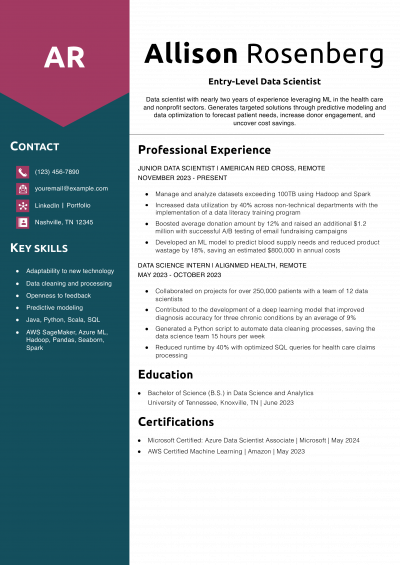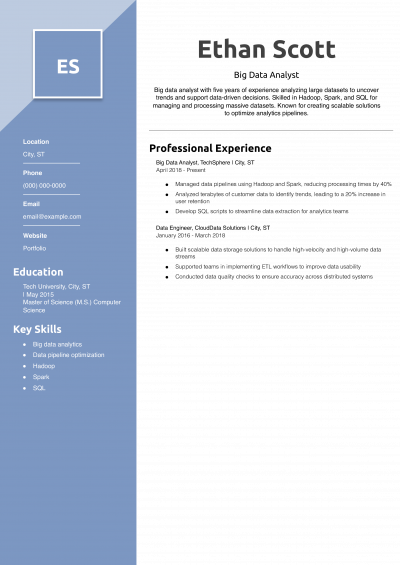Your data entry resume should convey a keen attention to detail and an aptitude for managing, organizing, and accurately recording data. It must show hiring managers that you can handle large volumes of information with precision and efficiency. This guide will help you create a results-driven resume demonstrating your ability to contribute to the success of any organization.
Key takeaways:
- Highlight technical expertise: Grab the hiring manager’s attention immediately by emphasizing your data entry specialties, such as software proficiency, typing speed, or accuracy rates.
- Feature quantifiable accomplishments: When describing your work history, use your own data to illustrate the impact you had in previous roles. Mention things like the volume of information processed or a percentage improvement in data retrieval.
- Use job-specific keywords: To optimize your resume for applicant tracking systems (ATS), include relevant data entry skills and terms mentioned in the job description throughout the document.
Most Popular Data Entry Resumes
Data Entry Clerk Resume Example
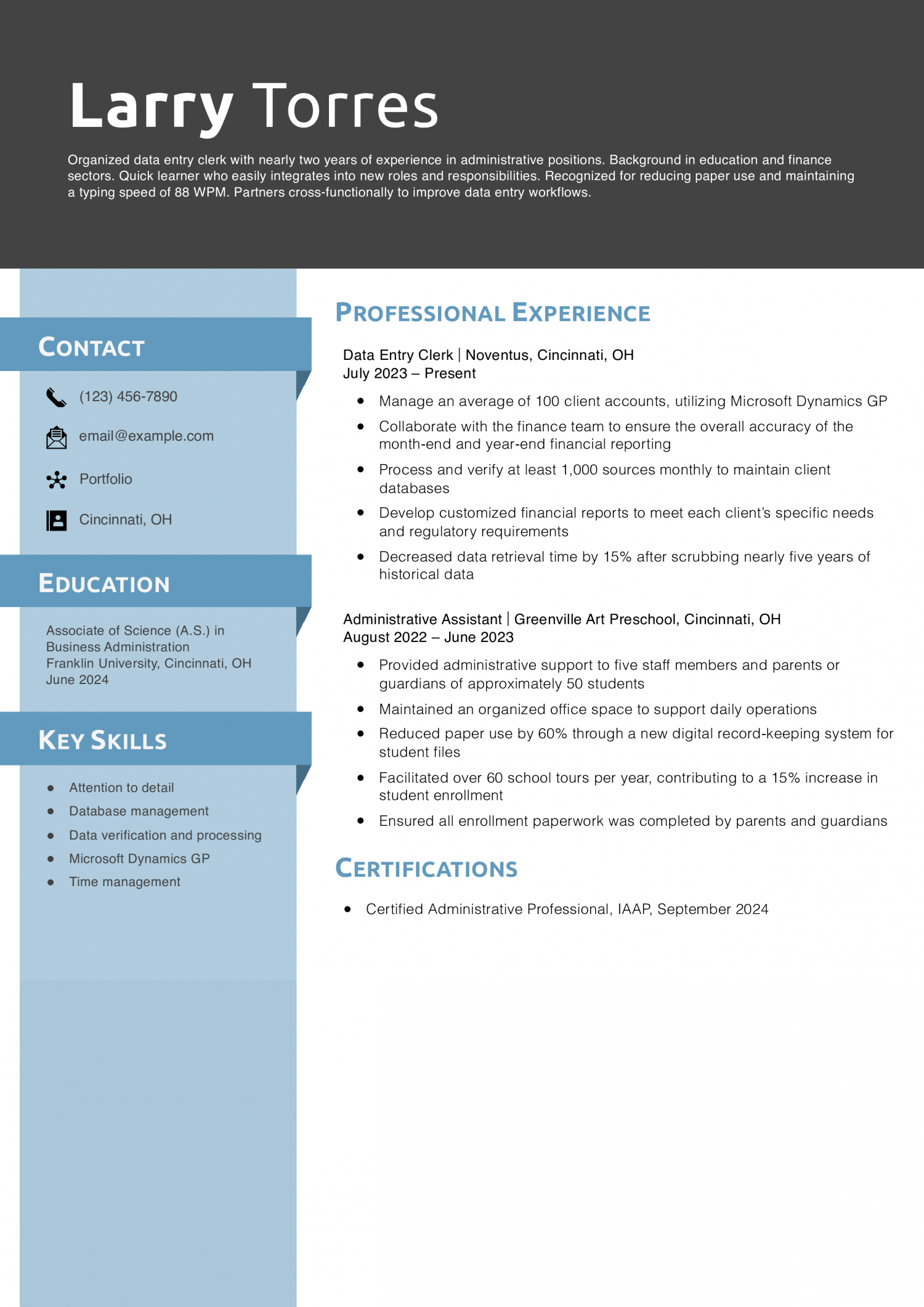
Why This Resume Is a Great Example
This resume highlights clear metrics—like reducing paper use by 60% and maintaining 88 WPM — that demonstrate both efficiency and technical skill. The reverse‑chronological format and concise profile make it easy for recruiters to quickly assess qualifications.
Key Tips
Highlight measurable efficiency gains and software proficiencies to show your technical strengths. For guidance on crafting an effective resume structure, see How to Make a Resume.
Data Entry Specialist Resume Example
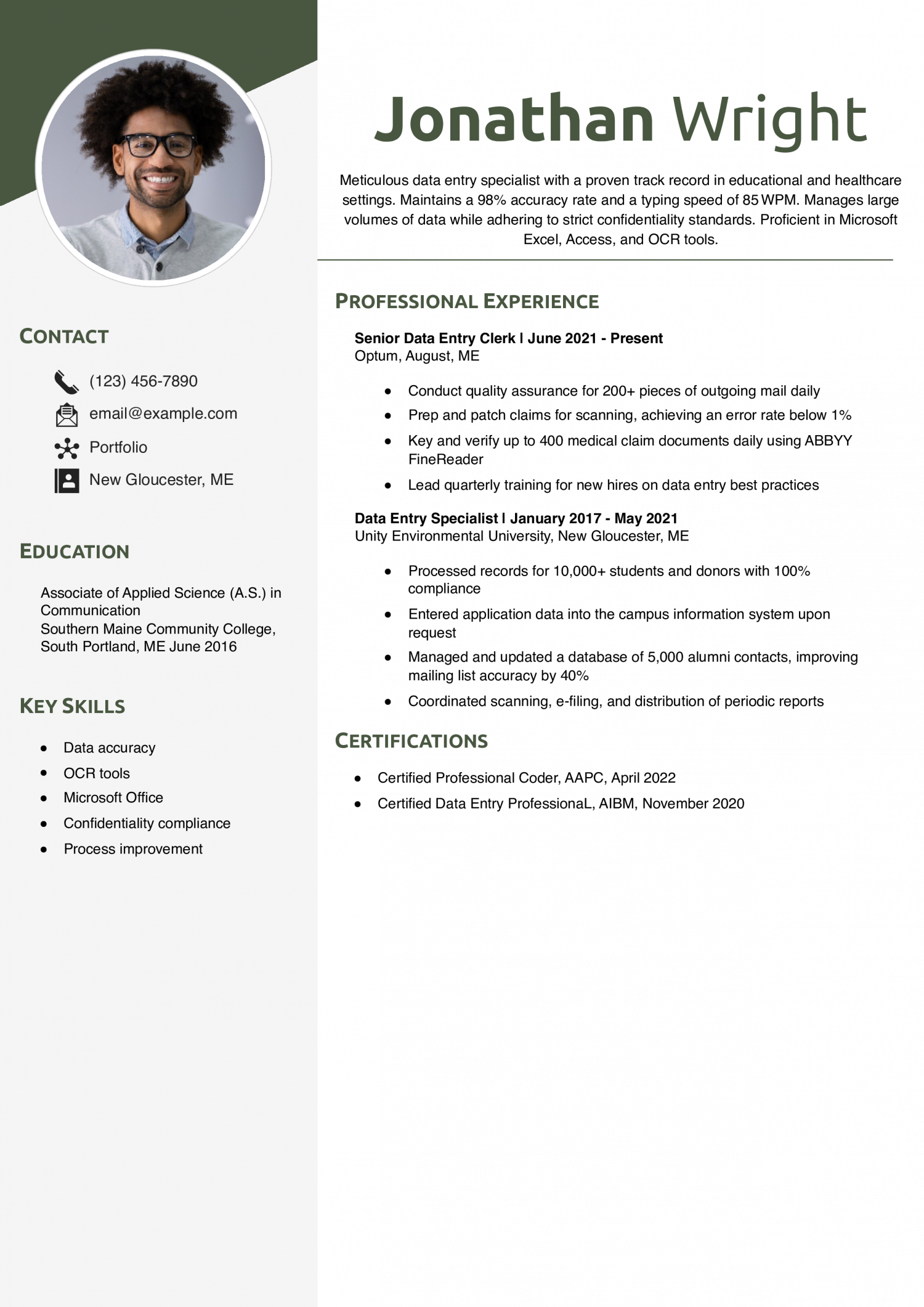
Why This Resume Is a Great Example
This resume showcases domain‑specific expertise — like OCR proficiency and medical claims processing, backed by quantifiable accuracy metrics. The bullet points are concise and clearly linked to critical responsibilities.
Key Tips
Emphasize specialized software skills and accuracy rates to stand out in niche roles. For advice on selecting the right skills, see Skills to Put on Resume.
Clinical Data Manager Resume Example

Why This Resume Is a Great Example
This resume highlights leadership in clinical data management with clear efficiency and error‑reduction metrics. The structured education and certification sections reinforce subject‑matter credibility.
Key Tips
Use a clear reverse‑chronological format to spotlight advanced degrees and certifications. For tips on choosing resume layouts, see Best Resume Formats.
Data Entry Operator Resume Example

Why This Resume Is a Great Example
This resume quantifies both volume and accuracy — two core operator metrics — and highlights automation skills that drive efficiency. The concise profile aligns perfectly with the detailed experience.
Key Tips
Emphasize both speed and accuracy metrics to demonstrate reliability. For sample objectives that focus your summary, see Resume Objective Examples.
Entry-Level Data Entry Clerk Resume Example
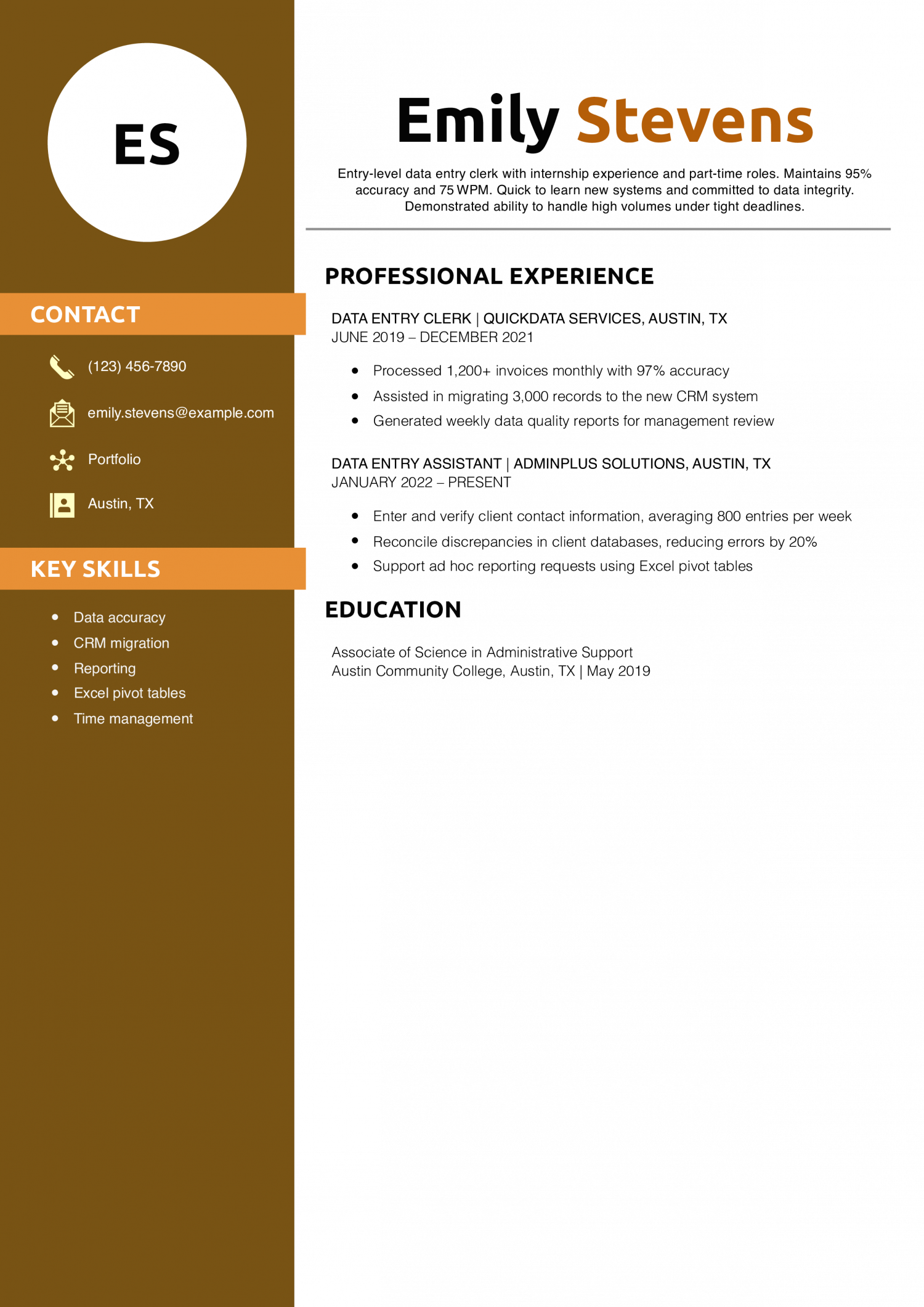
Why This Resume Is a Great Example
This resume demonstrates rapid progression from internship to a permanent role, with clear accuracy and volume metrics. The summary sets appropriate expectations for an entry‑level candidate.
Key Tips
Showcase early accomplishments and metrics to compensate for limited experience. For guidance on writing a strong resume summary, see How to Write a Resume Summary.
Data Entry Administrator Resume Example
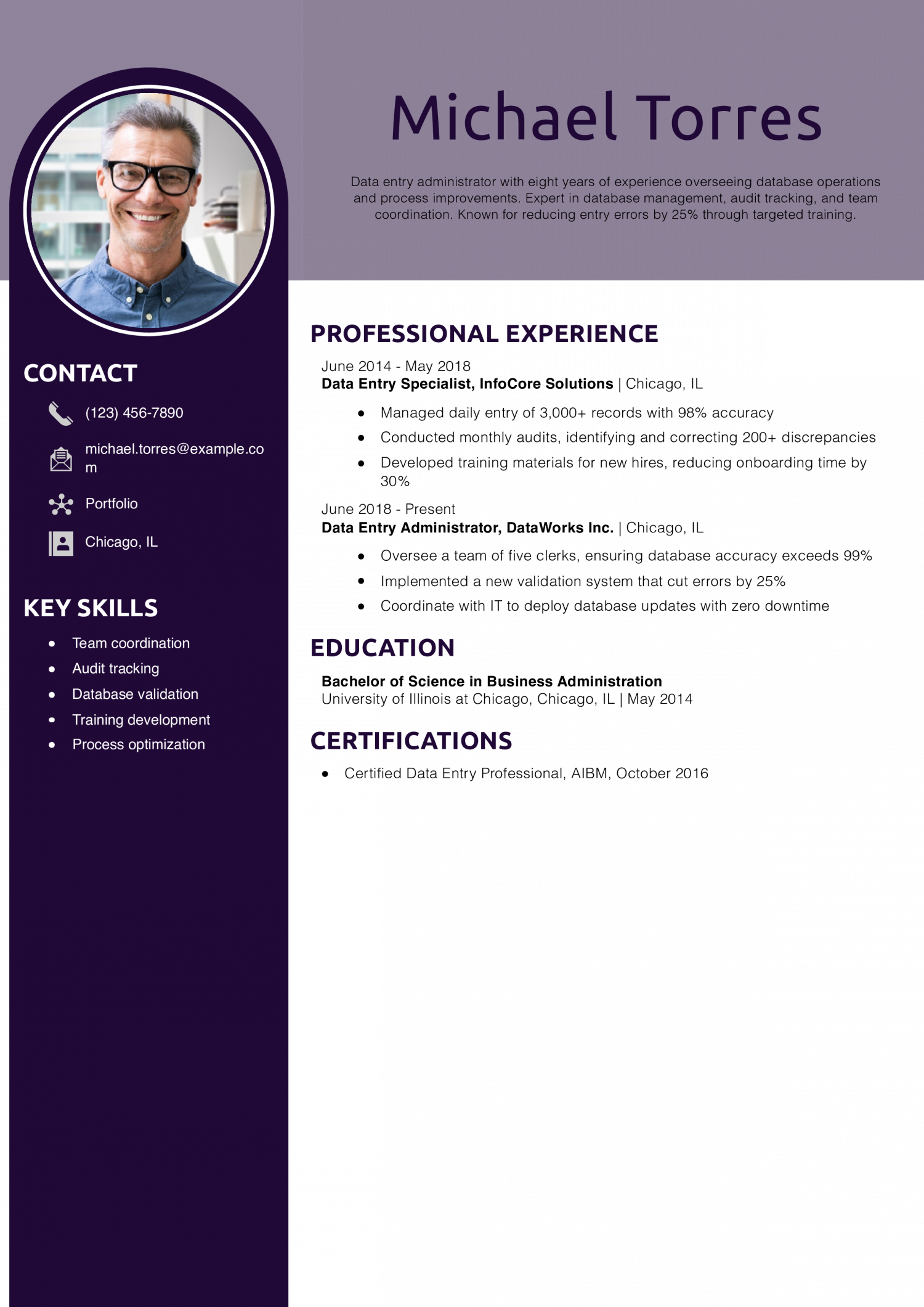
Why This Resume Is a Great Example
This resume illustrates both hands‑on data work and leadership in process improvement, backed by clear error‑reduction metrics. The progression from specialist to administrator is seamless.
Key Tips
Highlight team leadership alongside technical improvements to show managerial capability. For ideas on selecting the right hobbies section, see What Hobbies to Put on Resume.
Data Entry Analyst Resume Example
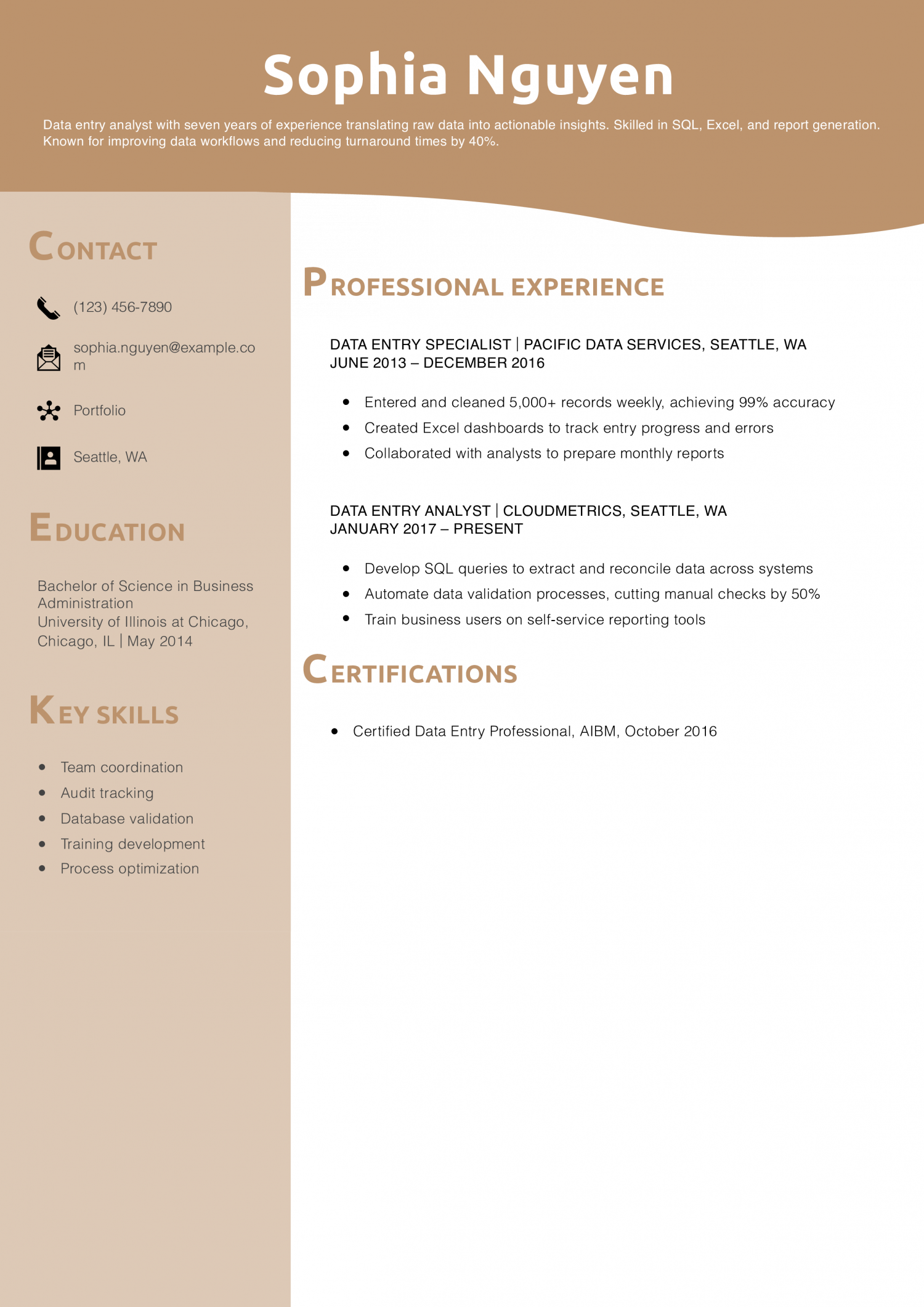
Why This Resume Is a Great Example
This resume combines technical analysis with data entry expertise, demonstrating how raw inputs drive business insights. The bullet points emphasize both accuracy and automation.
Key Tips
Showcase your analytical tools and automation skills to stand out. For advice on listing education details, see How to List Education on a Resume.
Data Entry Associate Resume Example
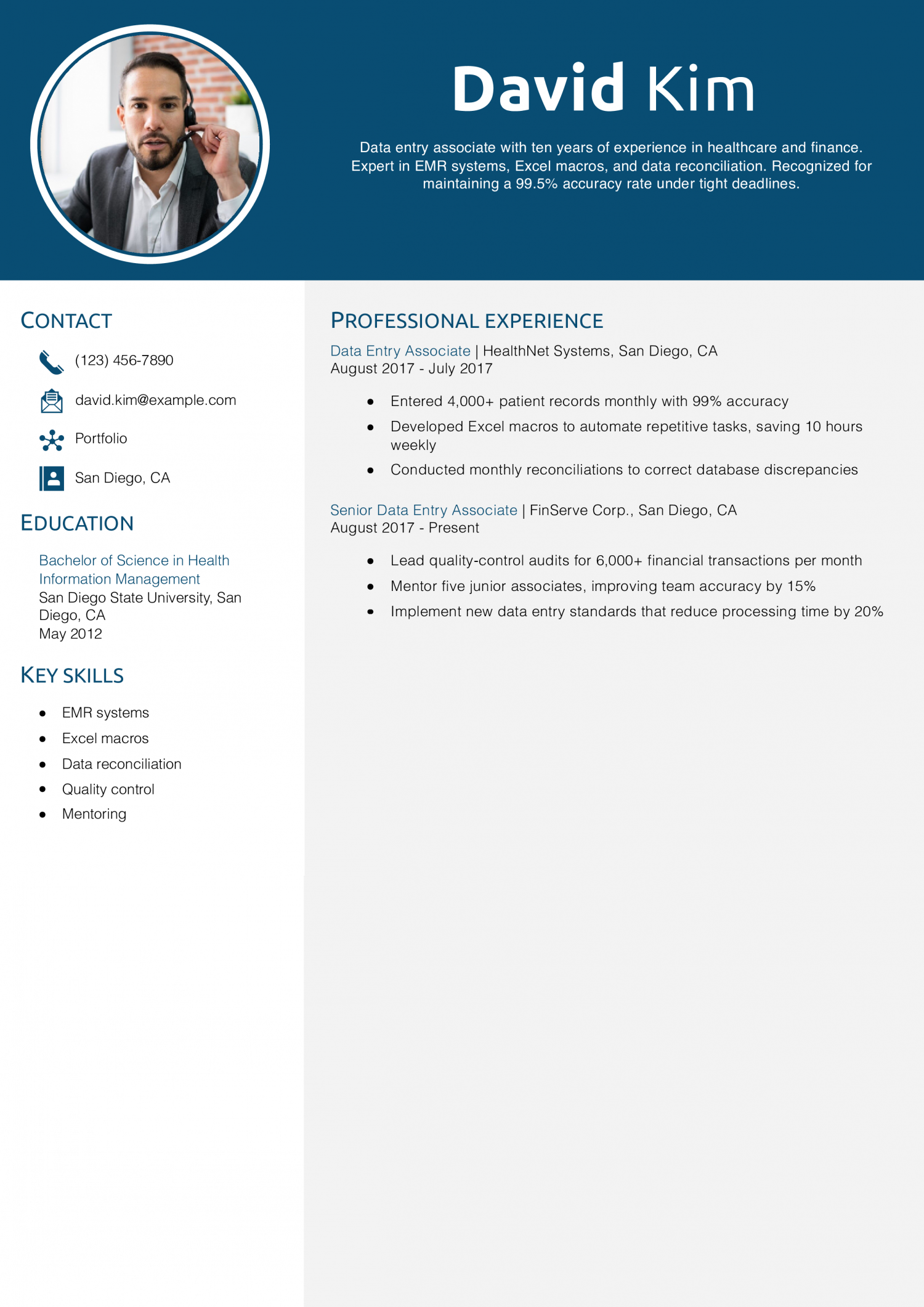
Why This Resume Is a Great Example
This resume highlights deep domain knowledge in both healthcare and finance, with strong automation and mentoring elements. The high‑accuracy metrics reinforce reliability.
Key Tips
Emphasize both domain‑specific systems and efficiency improvements. For insights into resume length, see How Far Should a Resume Go.
Data Entry Pharmacy Technician Resume Example
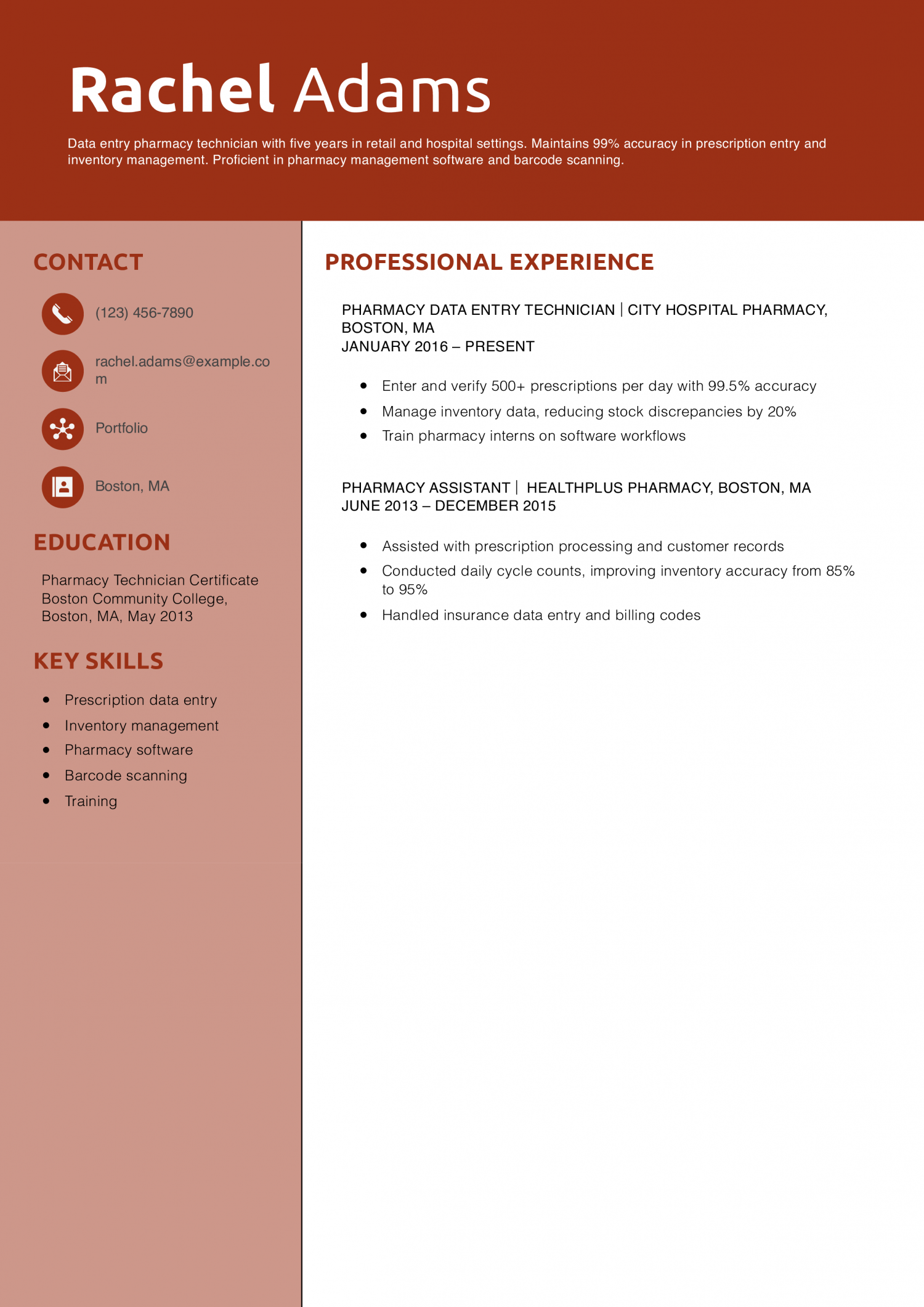
Why This Resume Is a Great Example
This resume showcases specialized pharmacy data entry skills with strong accuracy and inventory metrics. The clear profile sets the stage for the detailed experience.
Key Tips
Highlight domain‑specific software proficiencies and accuracy rates. For guidance on selecting content, see What to Put on a Resume.
Data Entry Supervisor Resume Example
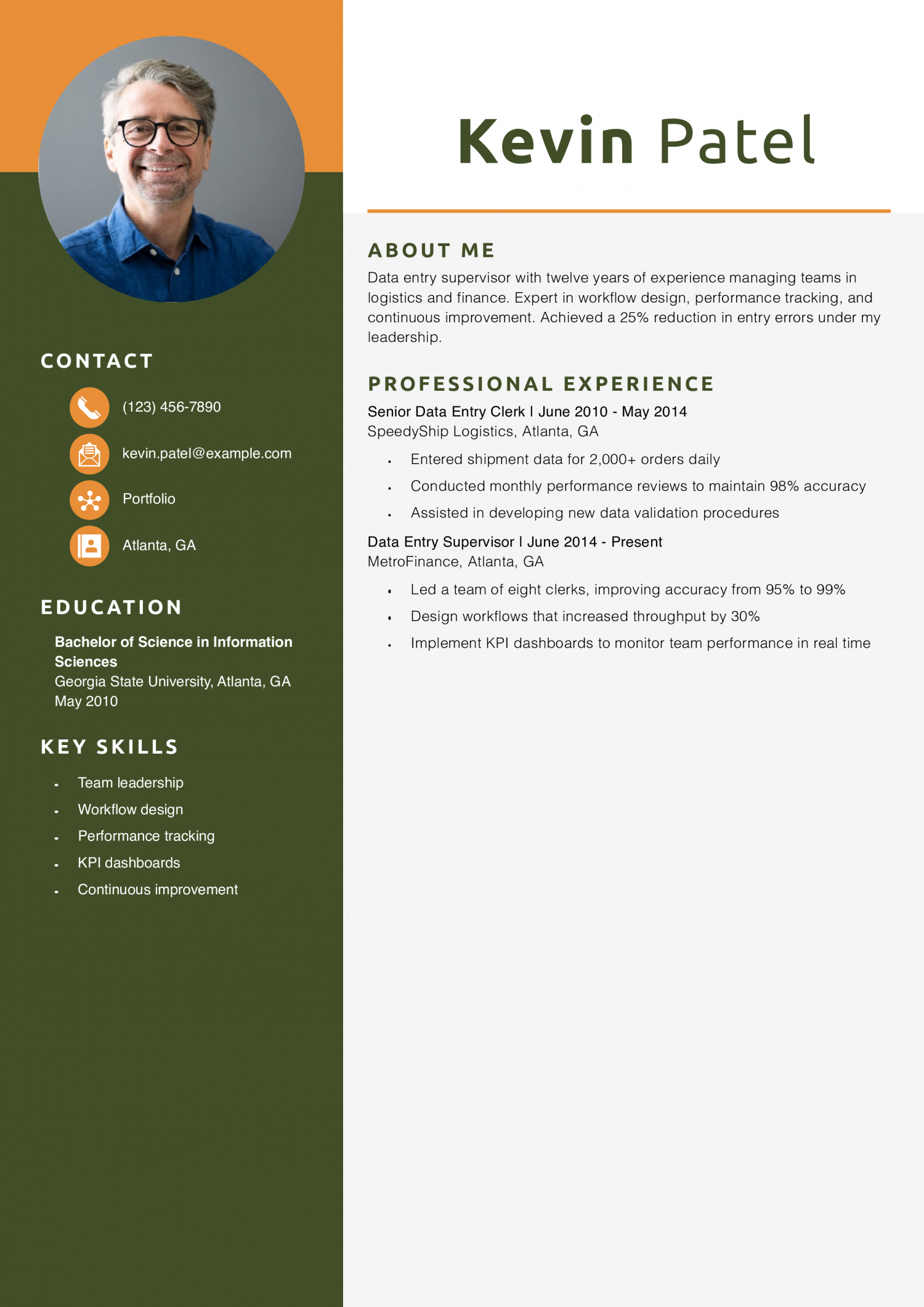
Why This Resume Is a Great Example
This resume combines strong leadership achievements with tangible accuracy and throughput improvements. The supervisory role is clearly distinguished from earlier hands‑on experience.
Key Tips
Use leadership metrics and error‑reduction data to showcase supervisory impact. For clarity on format differences, see CV vs. Resume: What Is the Difference.
Freelance Data Entry Resume Example
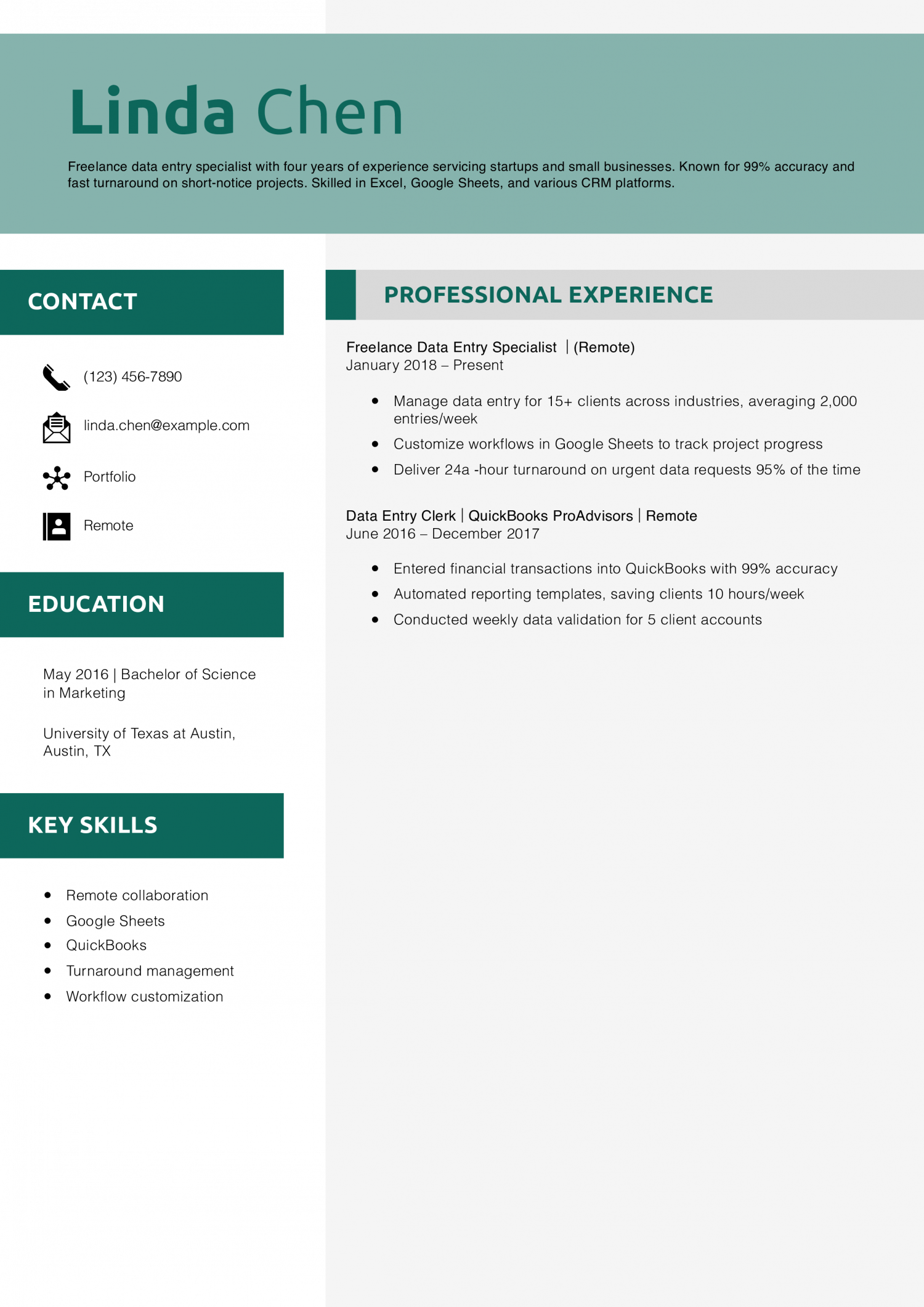
Why This Resume Is a Great Example
This resume emphasizes the candidate’s ability to manage multiple remote projects with high accuracy and fast delivery. The freelance role is clearly defined with quantitative metrics.
Key Tips
Showcase remote‑work efficiency and client impact with specific metrics. For strategies on entry‑level positioning, see How to Write a Resume With No Experience.
Data Entry Coordinator Resume Example
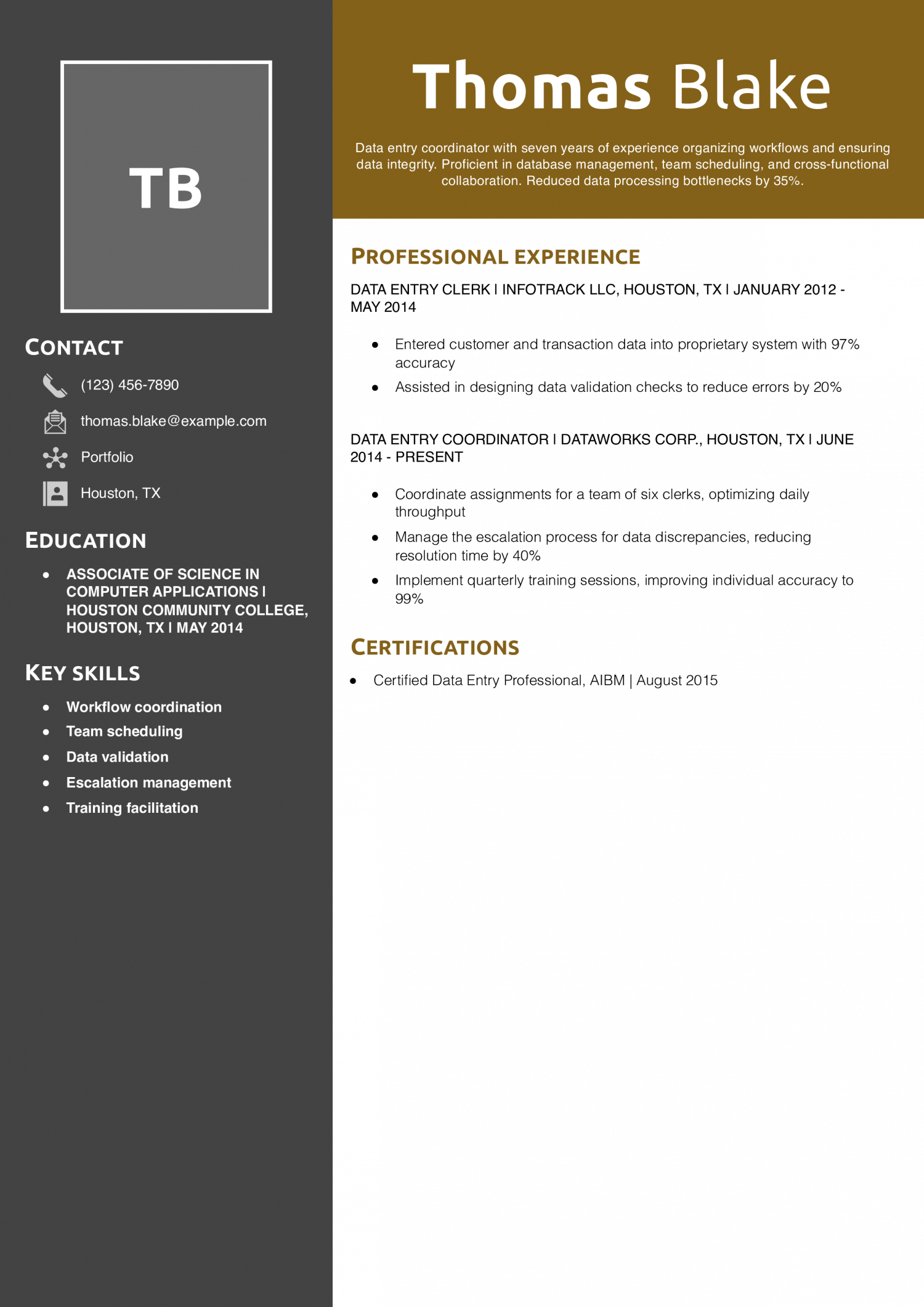
Why This Resume Is a Great Example
This resume highlights coordination and training skills alongside hands‑on data work, showing a balance of leadership and technical ability. The metrics on error resolution and training impact stand out.
Key Tips
Emphasize coordination outcomes and training improvements to show leadership. For formatting tips for students, see How a Resume Should Look for a College Student.
Data Entry Quality Assurance Resume Example
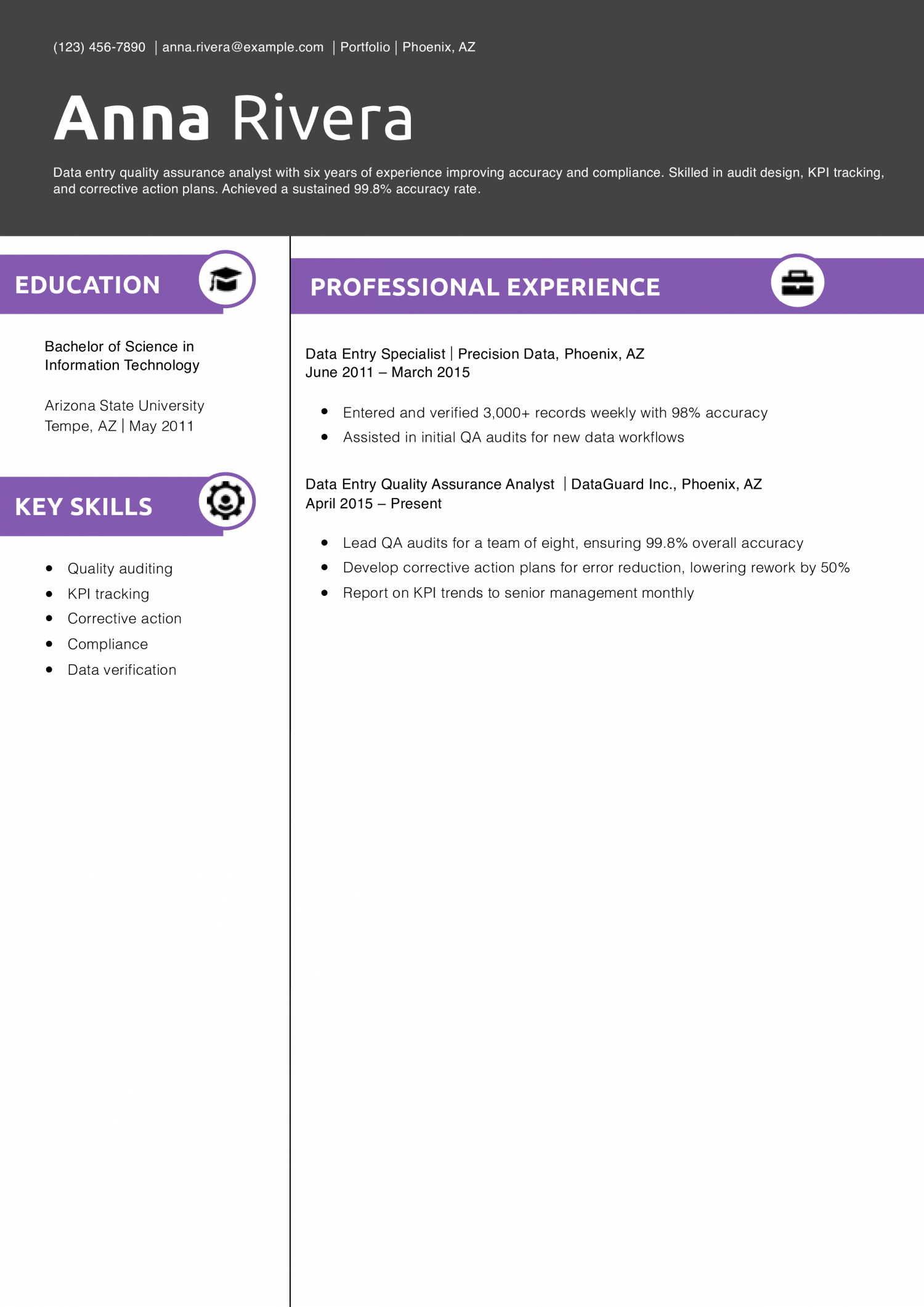
Why This Resume Is a Great Example
This resume showcases both detailed QA responsibilities and leadership in error reduction, underpinned by strong accuracy metrics. The chronological layout underscores steady career growth.
Key Tips
Highlight audit outcomes and KPI improvements to demonstrate QA expertise. For insights on refreshing your resume, see How to Update Your Resume.
Data Entry Team Lead Resume Example
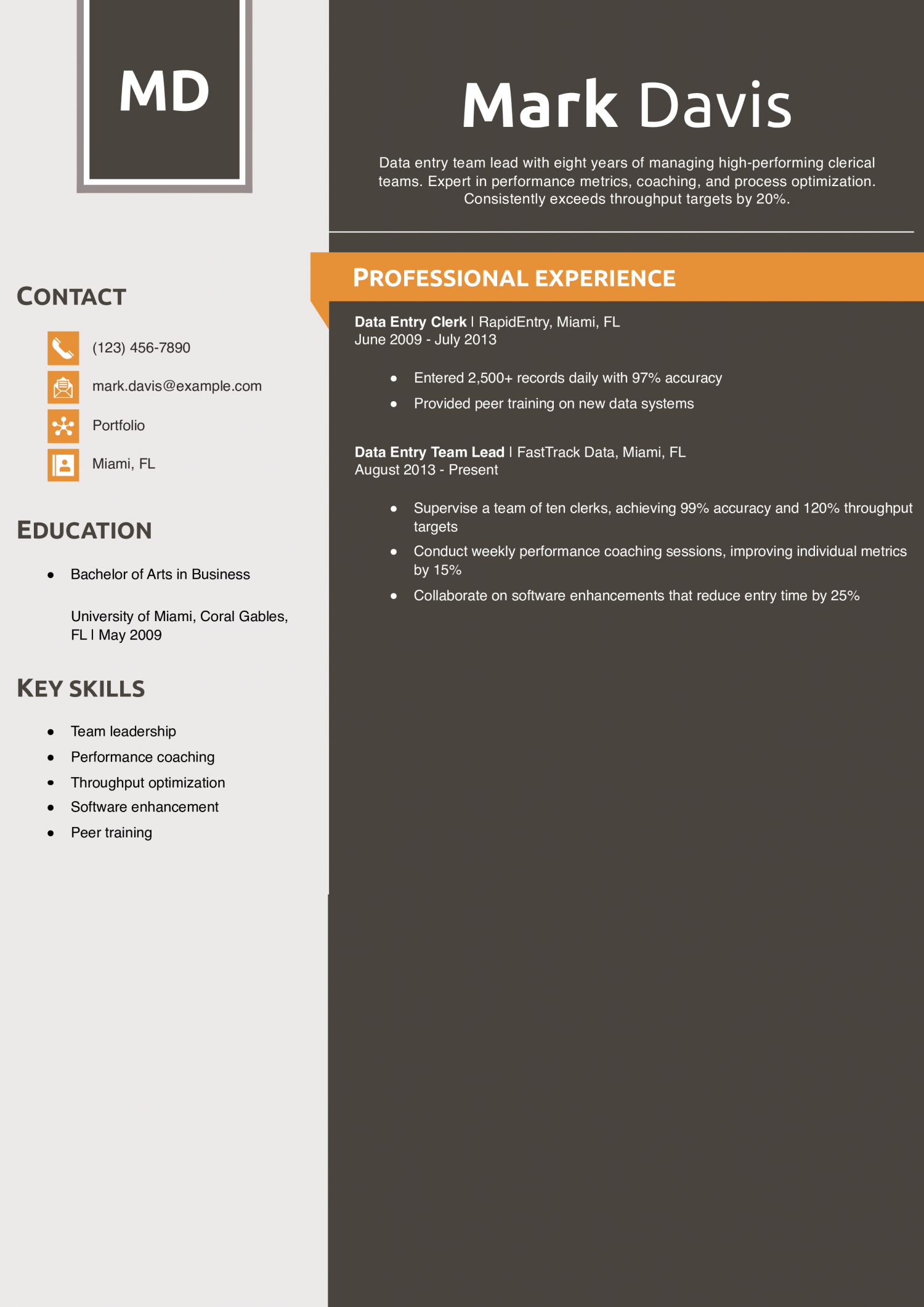
Why This Resume Is a Great Example
This resume combines strong leadership with quantifiable team improvements in accuracy and volume. The clear progression from clerk to lead underscores sustained performance.
Key Tips
Use leadership and throughput metrics to showcase team impact. For job title ideas, see Job Title Examples for Your Resume.
Data Entry Records Clerk Resume Example
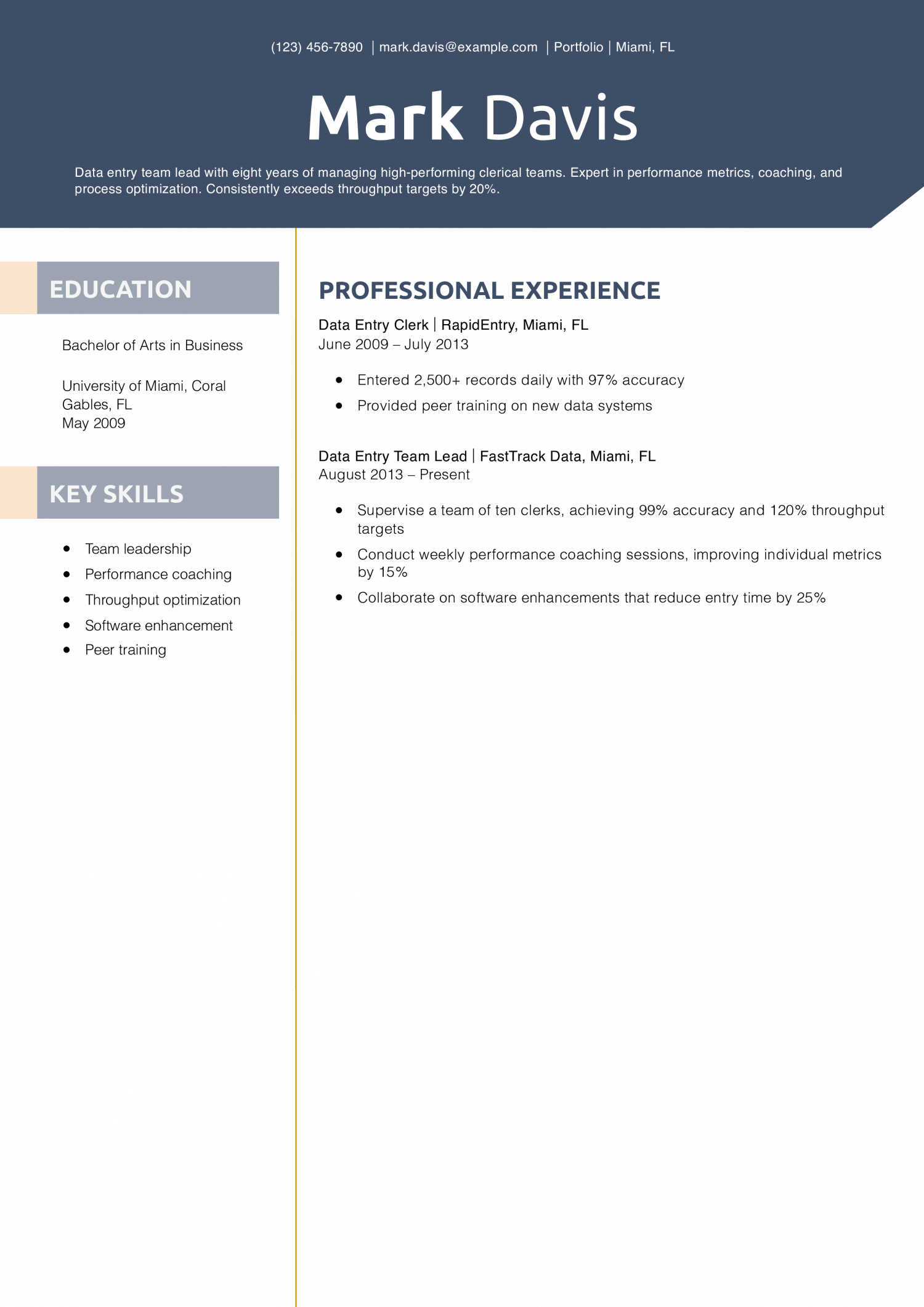
Why This Resume Is a Great Example
This resume highlights specialized records‑management skills and demonstrates clear efficiency gains in retrieval and scanning. The bullet points emphasize both process and training.
Key Tips
Showcase your impact on document workflows with percentage improvements. For help with personal statements, see Resume Personal Statement Examples.
Data Entry Compliance Officer Resume Example
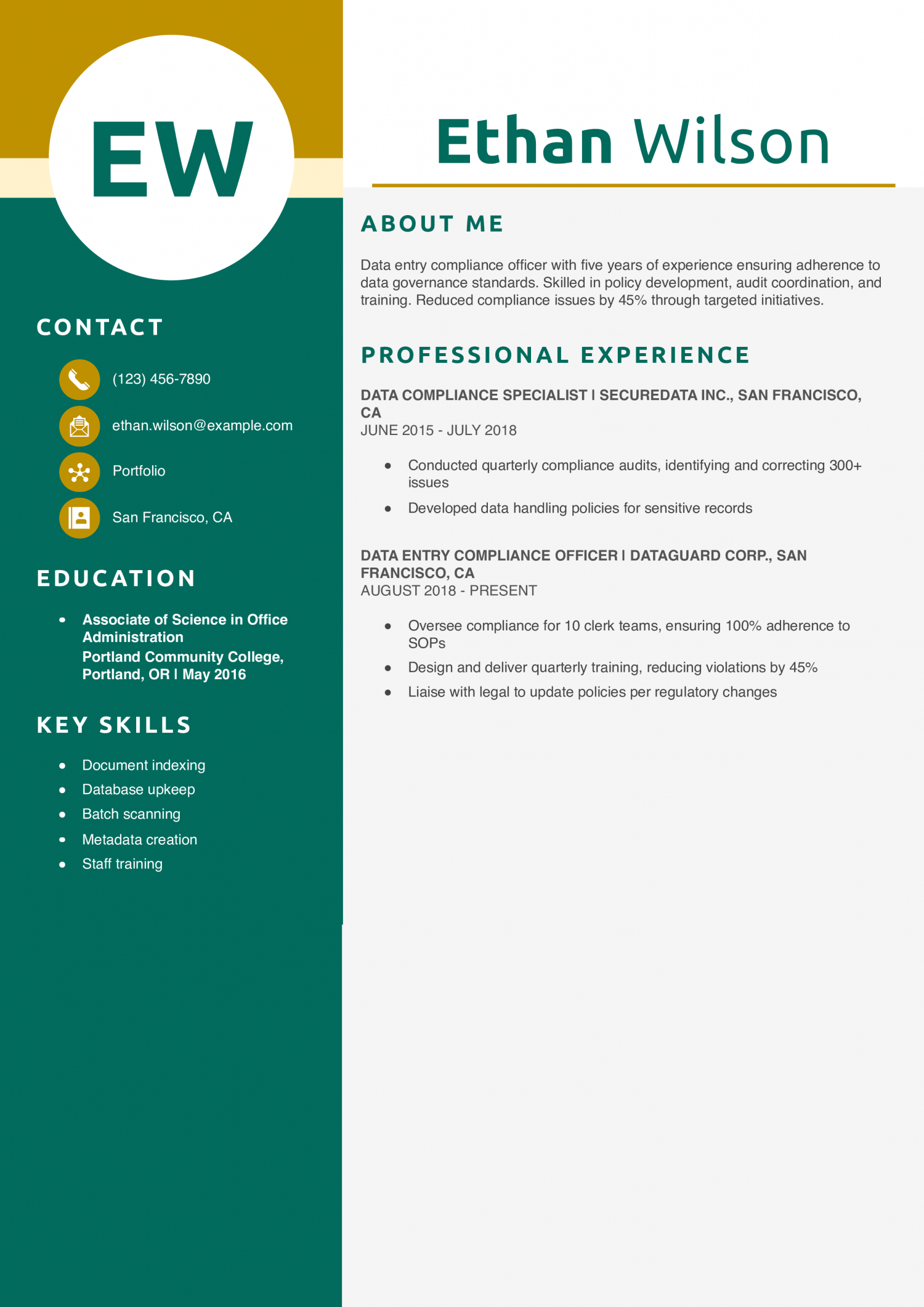
Why This Resume Is a Great Example
This resume emphasizes a compliance‑focused career path, with strong audit and policy achievements quantified. The structured profile and experience clearly convey authority.
Key Tips
Highlight compliance metrics and training impact to demonstrate governance expertise. For best‑looking resume inspiration, see Best‑Looking Resumes.
Data Entry Manager Resume Example

Why This Resume Is a Great Example
This resume ties managerial achievements to clear metrics, like doubling throughput and cutting costs, showing comprehensive business impact. The dual supervisory and managerial roles illustrate career progression.
Key Tips
Use financial and productivity metrics to underscore managerial contributions. For guidance on graduation dates, see How to Mention Year of Graduation in Resume.
Data Entry Trainer Resume Example
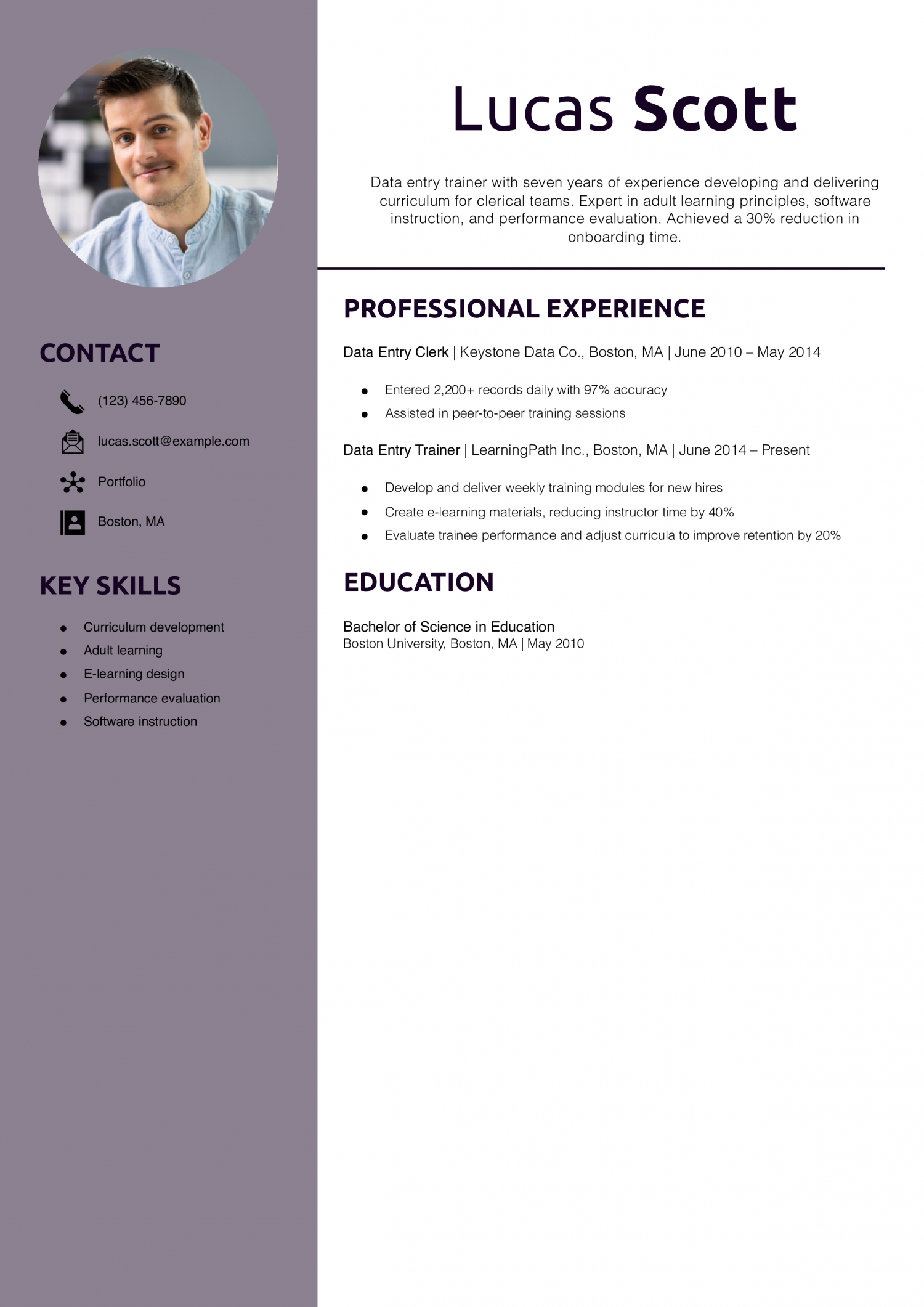
Why This Resume Is a Great Example
This resume highlights instructional design expertise and tangible reductions in training time. The progression from clerk to trainer illustrates an instructional career path.
Key Tips
Showcase training efficiencies and retention improvements to demonstrate instructional impact. For tips on AI‑driven resume enhancements, see ChatGPT Resume.
Data Entry Processor Resume Example
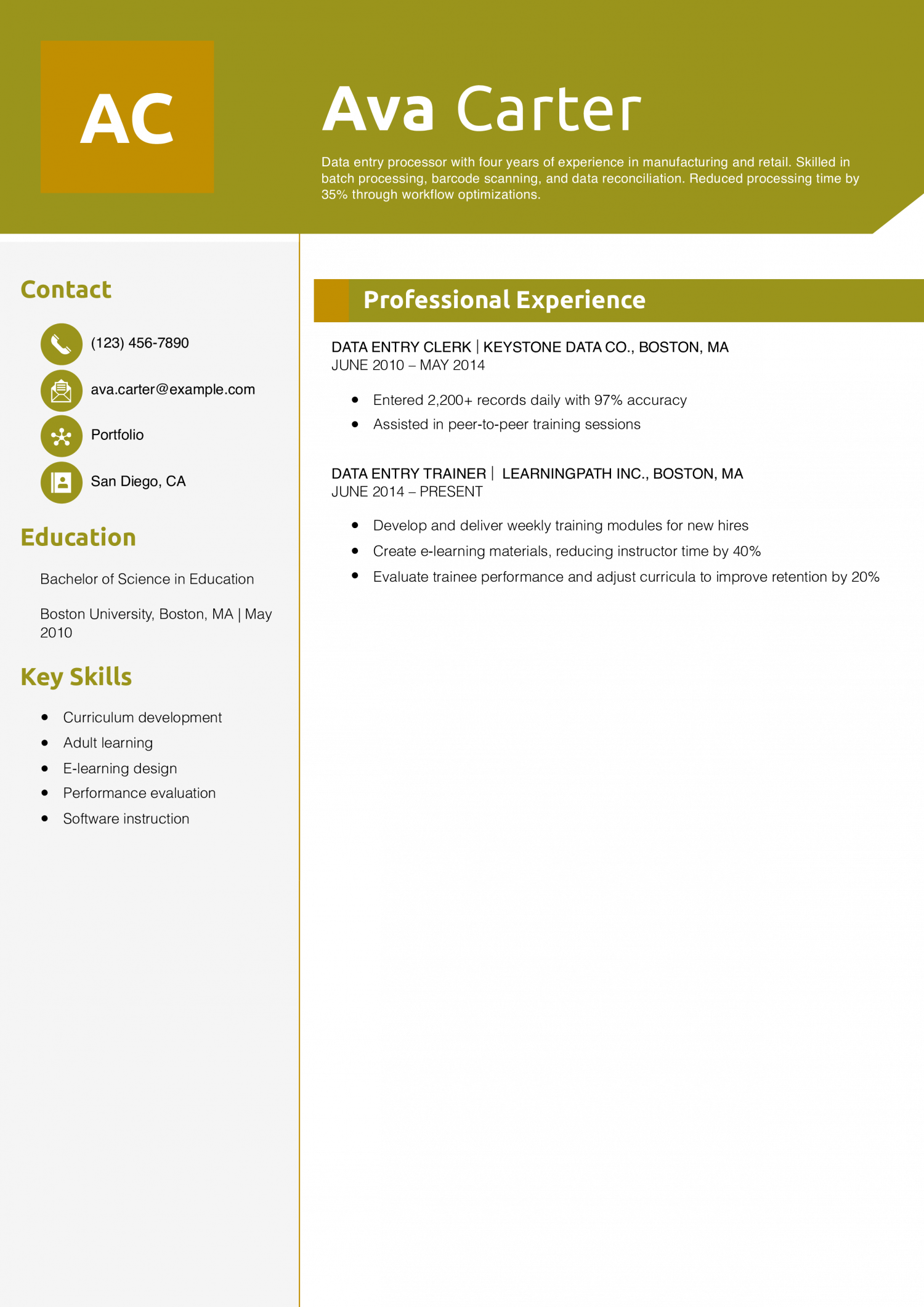
Why This Resume Is a Great Example
This resume combines high‑volume processing metrics with automation skills, demonstrating clear efficiency gains. The bullet points are concise and focused on impact.
Key Tips
Highlight both manual and automated processing efficiencies. For insights into teaching transferable skills, see Teaching Skills for Resume.
Data Entry Documentation Specialist Resume Example
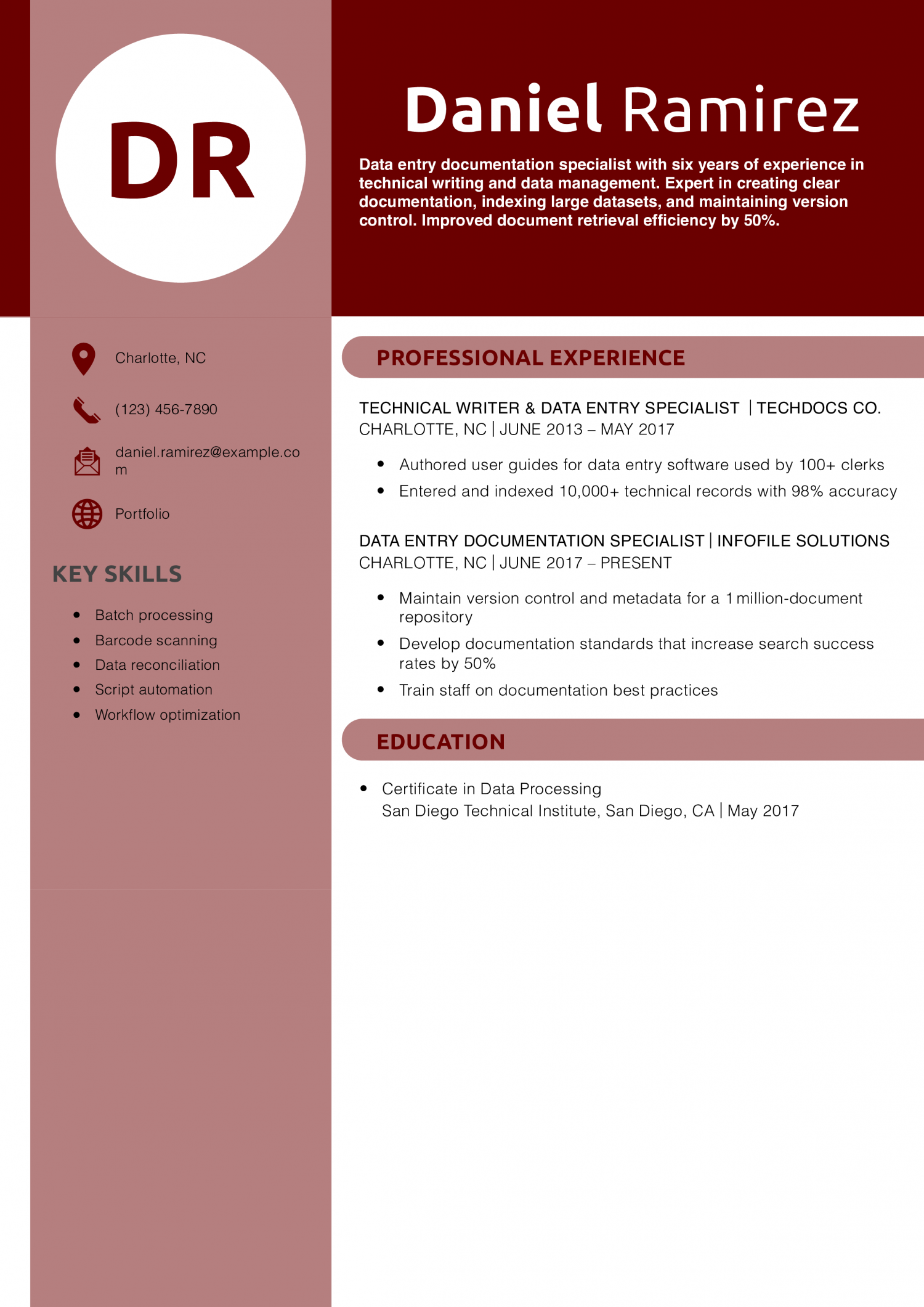
Why This Resume Is a Great Example
This resume highlights both documentation and data entry expertise with clear retrieval‑efficiency metrics. The blend of writing and technical skills makes it stand out.
Key Tips
Emphasize documentation standards and retrieval metrics to showcase your hybrid skills. For guidance on presenting work history, see Work Experience on a Resume.
Data Entry Text-Only Resume Examples and Templates
How To Write a Data Entry Resume Example
Using a professional resume template ensures your clerical work history is presented clearly. Your data entry resume should include these sections:
- Contact information
- Profile
- Key skills
- Professional experience
- Education and certifications
1. Share your contact information
Your contact information is the first thing hiring managers will look for when they’re ready to schedule an interview. At the top of your document, list your full name, phone number, email address, location, and links to any online professional profiles. Ensure everything is up-to-date before submitting your application.
Example
Your Name
(123) 456-7890
[email protected]
City, State Abbreviation Zip Code
LinkedIn
2. Use a dynamic profile summarizing your qualifications
The profile or objective statement of your data entry resume serves as a concise, compelling career summary. It should highlight your relevant clerical skills, years of experience, and key strengths. This is your chance to grab the attention of hiring managers and get them invested in who you are as a data entry professional.
Are you a fast typer? An Excel expert? Maybe you have a data entry certification. Mention these qualities and any other skills you have that match those from the job description. This shows that you’re well-qualified for the job and will help your resume perform well if employers are using an ATS program.
Senior-Level Profile Example
Certified Clinical Data Manager with more than 10 years in the clinical research industry. Manages complex data landscapes while navigating confidentiality of protected health care information (PHI). Leader who focuses on streamlining data processes to improve team accuracy and efficiency. Master’s degree in data science and analytics.
Entry-Level Profile Example
Organized data entry clerk with nearly two years of experience in administrative positions. Background in education and finance sectors. Quick learner who easily integrates into new roles and responsibilities. Recognized for reducing paper use and maintaining a typing speed of 88 WPM. Partners cross-functionally to improve data entry workflows.
3. Add a compelling section featuring your data entry experience
When detailing your work history, keep descriptions brief but informative. Give a full picture of your data entry skills and experiences without overwhelming the reader. Data entry specialists work in nearly every sector, so use industry-specific examples relevant to the job you’re applying for. Hiring managers need to know that you can meet their specific clerical needs.
For example, if you’re applying for a role within the health care industry, mention your experience with medical billing systems and managing patient data. Emphasize your ability to handle sensitive medical records accurately and in compliance with the Health Insurance Portability and Accountability Act (HIPAA).
Senior-Level Professional Experience Example
Data and Administrative Coordinator, Global Health Research, Montgomery, AL
November 2021 – present
- Oversee data handling, integrity, and quality control for three simultaneous research projects
- Generate three team weekly work schedules and distribute agendas during regular team meetings
- Improved data report accuracy by 30% with the utilization of custom templates and a streamlined verification process
- Register and manage over 500 annual shipments received, allocating research materials accurately
- Reduced laboratory supply spending by 15% through meticulous order tracking
Entry-Level Professional Experience Example
Data Entry Clerk, Noventus, Cincinnati, OH
July 2023 – present
- Manage an average of 100 client accounts, utilizing Microsoft Dynamics GP
- Collaborate with finance team to ensure overall accuracy of month-end and year-end financial reporting
- Process and verify at least 1,000 sources monthly to maintain client databases
- Develop customized financial reports to meet each client’s specific needs and regulatory requirements
- Decreased data retrieval time by 15% after scrubbing nearly five years of historical data
Resume writer’s tip: Quantify your experience
To help hiring managers understand the value you can bring to their company, use numbers to describe previous work. Instead of only listing your data entry duties, include a few tangible results. For example, use percentages to describe how you increased productivity or use dollar amounts to outline how much money you saved a past employer.
Do
- “Increased data entry productivity by 30% by implementing a new workflow process.”
- “Saved the company $15,000 annually by identifying and correcting billing errors.”
Don’t
- “Performed data entry duties for various departments.”
- “Responsible for handling invoices and ensuring accuracy.”
Resume writer’s tip: Tailor your resume for each application
Depending on your industry and job description, each employer will have their own set of objectives, challenges, and priorities for data entry. Your goal is to tailor your resume for each job you apply for to ensure your application is relevant and engaging. That means using key language from the job description within your document.
Suppose you’re applying for a data entry job with a financial services firm and the job announcement mentions “high volume data processing.” If you have experience handling large amounts of data, you would include this phrase in your skills list or in the professional experience section where you can describe specific examples.
What if you don’t have experience?
Even if you haven’t worked directly in data entry, you likely have transferable skills. Think of times you’ve performed clerical tasks. This can be from school, volunteer work, internships, and other seemingly unrelated jobs. Focus on abilities like attention to detail, fast and accurate typing, proficiency in Microsoft Office (especially Excel), and any experience with database software.
If you’ve taken related coursework, list it in your education section. Classes revolving around typing, office software, data analysis, and basic computer skills would all demonstrate an ability to perform data entry tasks.
4. Include education and certifications relevant to data entry
Data entry or information clerk positions usually require at least a high school diploma or GED. Regardless of your level of education, list your highest degree first. You can also mention specific coursework relevant to data entry. This could include classes in computer science, business administration, and data processing.
If you have pertinent software, data entry, or other industry-specific certifications, mention those here as well. While they may not guarantee you a call for an interview, they can set you apart from other applicants.
Education
Template:
[Degree Name]
[School Name], [City, State Abbreviation] | [Graduation Year]
Example:
Associate of Applied Science (A.S.) in Communication
Southern Maine Community College, South Portland, ME | June 2016
Certifications
Template:
[Certification Name], [Awarding Organization], [Completion Year]
Examples:
Certified Data Entry Professional, American Institute of Business Management, 2020
5. List key skills and proficiencies for data entry
Data entry involves more than just typing information into a computer — it requires a range of skills like organization, teamwork, software proficiency, and an eye for detail. To show hiring managers you would be a valuable asset to their office, create a list of technical and interpersonal skills that align with the needs of the company. Here’s a list of skills you may encounter as you write your data entry resume:
| Key Skills and Proficiencies | |
|---|---|
| 110-key typing | Alpha-numeric data entry |
| Attention to detail | Communication |
| Customer relationship management (CRM) software (Salesforce, HubSpot) | Data cleaning |
| Database software (Microsoft Access, SQL) | Dependability |
| Efficiency | Ethical conduct |
| Excel proficiency | Multitasking |
| Organization | Punctuality |
| Report generation | Self-motivation |
| Spreadsheet management | Teamwork |
| Typing speed | Word processing software (Word, Google Docs) |
Resume writer’s tip: Use specific action verbs
Action verbs help hiring managers see you as an active, engaged data entry specialist. Instead of bogging down your resume with redundant first-person language like, “I was responsible for typing,” use action verbs to show how you “organized,” “streamlined,” and “enhanced.” These dynamic words work best in your professional experience section. Start each bullet point with an action verb like the ones below:
| Action Verbs | |
|---|---|
| Analyzed | Cataloged |
| Compiled | Consolidated |
| Digitized | Implemented |
| Maintained | Organized |
| Processed | Recorded |
| Retrieved | Systematized |
| Transcribed | Updated |
| Verified | |
How To Pick the Best Data Entry Resume Template
As a data entry specialist, you know how important it is to present a clear, well-organized document. With resumes, it all starts with the right template. The best template for a data entry resume has a clean and simple design. Opt for a style that clearly highlights your key data points and allows readers to easily navigate the page. Avoid overly stylized and colorful designs that often only distract.
Frequently Asked Questions: Data Entry Resume Examples and Advice
With employment for information clerks (including data entry specialists) projected to decrease over the next decade, the job market will only grow increasingly competitive. You'll need to make a clear connection with hiring managers by aligning each resume with the company's unique requirements. Use the job descriptions of every role you apply for as a guide.
For instance, imagine a company was on the search for someone who could streamline their data entry process. In that case, you would highlight any success you've had in implementing an automated data validation tool or developing macros to expedite processing time. Show how you've improved efficiency and accuracy in the past.
To best present your data entry skills and past work success, use a **chronological format**. This resume style highlights your work history in reverse order, starting with your most recent positions. It allows hiring managers to easily see your career progression and the impact you've made over time, making it an excellent choice whether you're new to the field or a data entry expert. This format is ideal for showcasing a clear, linear growth in your skills and experience.
To optimize your Data Entry CV for ATS, make sure to incorporate the right keywords from the job description, especially in sections like skills, experience, and certifications. Stick to a clean, straightforward layout that avoids complicated formatting or images, as these can confuse the ATS. This will help your CV get past the automated systems and into the hands of hiring managers.
Include a cover letter with your resume
Add a personal touch to your application with a customized cover letter. While a resume provides hard data for hiring managers, a letter gives the story behind the bullet points. It’s your chance to add context and convey your enthusiasm for a new data entry position. Take this opportunity to connect with potential employers and share why you’re the best data entry specialist for the job.
Check Out Related Examples
Resume Templates offers HR approved resume templates to help you create a professional resume in minutes. Choose from several template options and even pre-populate a resume from your profile.

